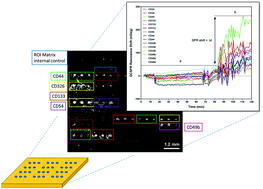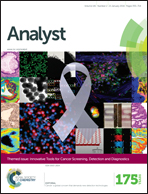Grating coupled SPR microarray analysis of proteins and cells in blood from mice with breast cancer
Abstract
Biomarker discovery for early disease diagnosis is highly important. Of late, much effort has been made to analyze complex biological fluids in an effort to develop new markers specific for different cancer types. Recent advancements in label-free technologies such as surface plasmon resonance (SPR)-based biosensors have shown promise as a diagnostic tool since there is no need for labeling or separation of cells. Furthermore, SPR can provide rapid, real-time detection of antigens from biological samples since SPR is highly sensitive to changes in surface-associated molecular and cellular interactions. Herein, we report a lab-on-a-chip microarray biosensor that utilizes grating-coupled surface plasmon resonance (GCSPR) and grating-coupled surface plasmon coupled fluorescence (GCSPCF) imaging to detect circulating tumor cells (CTCs) from a mouse model (FVB-MMTV-PyVT). GCSPR and GCSPCF analysis was accomplished by spotting antibodies to surface cell markers, cytokines and stress proteins on a nanofabricated GCSPR microchip and screening blood samples from FVB control mice or FVB-MMTV-PyVT mice with developing mammary carcinomas. A transgenic MMTV-PyVT mouse derived cancer cell line was also analyzed. The analyses indicated that CD24, CD44, CD326, CD133 and CD49b were expressed in both cell lines and in blood from MMTV-PyVT mice. Furthermore, cytokines such as IL-6, IL-10 and TNF-α, along with heat shock proteins HSP60, HSP27, HSc70(HSP73), HSP90 total, HSP70/HSc70, HSP90, HSP70, HSP90 alpha, phosphotyrosine and HSF-1 were overexpressed in MMTV-PyVT mice.

- This article is part of the themed collection: Innovative Tools for Cancer Screening, Detection and Diagnostics

 Please wait while we load your content...
Please wait while we load your content...